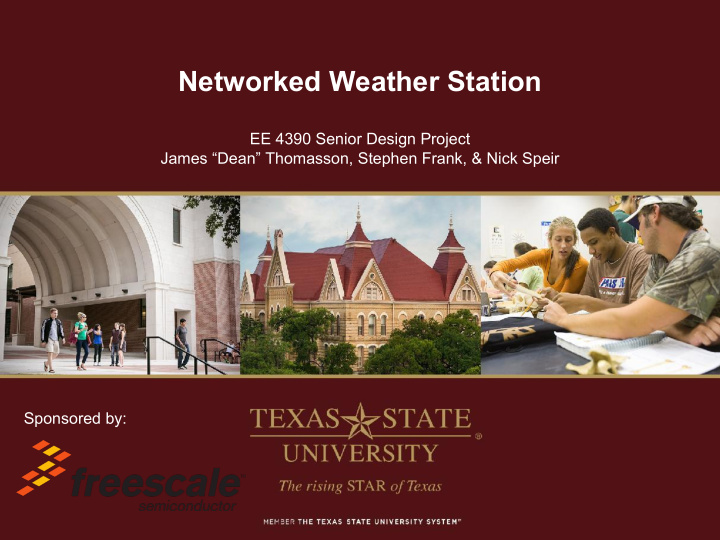



Networked Weather Station EE 4390 Senior Design Project James “Dean” Thomasson, Stephen Frank, & Nick Speir Sponsored by:
Goals (Primary) ● Become familiar with the IoT (Internet of Things) framework and IEEE 802.15.4 (ZigBee) networking infrastructure by: ○ Collecting inputs from various weather sensors installed in the Smart Lab. ○ Aggregate, package and transmit the collected values to a central hub. ○ Store the final data in a central database. The final design should focus on: ● ○ Low energy (low power consumption) remote nodes. ○ Small size and low cost. ● Final design reports to be submitted to Freescale to be used as reference design material or as application notes.
Goals (Secondary) ● Display data from the database using analytical graphing software. ● Analyze the effects of loading the ZigBee network with a lot of sensors and traffic. ● Provide remote power source for the weather station (i.e. solar panels or batteries).
Gap Analysis Table
Snapshot Networked Weather Sensor This project will focus on the - 6 Variable Sensors Hardware and Networking - Networked over Zigbee required to complete the task. - Transmits minimally Third-party analytical software - Stores Raw Data in will be used for analysis. Database Risks - Power Consumption 1) Planning and Ordering - Possibly Remote Power 2) Programming / Assembly - Packaging with Zigbee 3) Troubleshooting / Testing Protocol 4) Custom Board Design - Data Loss with Network (PCB) Crash
Technology Attributes & Solutions Transmission Rate: ● Transmit at the minimum rate possible to conserve power ○ Transmit packets of information through Zigbee network using the existing packet protocol. Environmental Hardening For Outdoor Environment: ● A weather resistant enclosure will be required for this device ○ This enclosure will have to have adequate sealed ports for the sensors. Software to Interpret and Send Data: ● The microcontroller will be programmed to interpret sensor output to a specified degree of accuracy, and transmit it via ZigBee using the correct protocol and at a determined rate. Power Source for Sensors and Transmitter: ● The total power consumption of the microcontroller board and all sensors will be used to determine battery capacity and possible solar charging capabilities. Transmission Range: ● A transmitter is required that is low power, but can produce a strong enough signal to reach the database
Technology Attributes & Solutions Our Weather Sensor will use mostly Freescale’s existing hardware to adapt to the existing weather sensors on the market. -Low Power Consumption -Wirelessly Networked via Zigbee -6 sensors -Temperature -Ambient Light -Barometer -Relative Humidity -Wind Speed/Direction -Completely Stand Alone
Planning - Technology Outline
Planning - 2014 Schedule Oct. 27th In-Class Presentation Day Oct. 29th Project Scope & Hardware Defined Place Orders for Necessary Hardware Begin Software Development Nov. 19th Weather Station Physically Assembled Begin Software Testing / Debugging Dec. 3rd Prepare Hardware / Software for Presentation Dec. 5th Senior Project Day
Planning - Finances Allocated Budget: ≈ $200 for non-Freescale Parts Freescale Parts: ● Tower KL46Z Microprocessor Board $150 ● Tower Elevators $80 Tower Analog to Digital Converter Board $120 ● ● Adapter Board $45 ● ZigBee Radio $-- ● Tower Prototyping Board $15 Freescale Barometric Pressure Sensor $15 ● Total: $425 Non-Freescale Parts: ● Wind Speed/Direction & Rain Sensor $70 ● Light Sensor $7 Temperature Sensor $2 ● Total: $79 Note: Prices do not include taxes or shipping costs
Planning - Dependencies & Risks ZigBee (IEEE 802.15.4) Networking ● Large number of sensors on network can cause interference ● Specific hardware must be used Transmission Distance ● Remote Outdoor Weather Station ● Possible Remote Power Supply ● Weather Resistant Enclosure ● Sensor Range / Resolution / Sampling Rate Data Transmission & Storage Large amount of data ● ● Database Structuring ● Transmission Packaging and Transmission Rate ● Data Loss
Recommend
More recommend